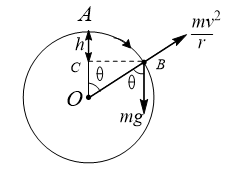Physics-
General
Easy
Question
In figure, a particle is placed at the highest point  of a smooth sphere of radius
of a smooth sphere of radius  . It is given slight push, and it leaves the sphere at
. It is given slight push, and it leaves the sphere at  , at a depth
, at a depth  vertically below
vertically below  such that
such that  is equal to
is equal to

The correct answer is: 
If  velocity acquired at
velocity acquired at  , then
, then

The particle will leave the sphere at  , when
, when



Which gives 
Related Questions to study
Maths-
Maths-General
Maths-
Maths-General
chemistry-
angle would be maximum in
angle would be maximum in
chemistry-General
physics-
A circular loop of radius 20cm is placed in a uniform magnetic field plane the loop carries a current 1A in the direction shown in figure The magnitude of torque acting on the loop is nearly

A circular loop of radius 20cm is placed in a uniform magnetic field plane the loop carries a current 1A in the direction shown in figure The magnitude of torque acting on the loop is nearly

physics-General
physics-
Two 1ong wires are placed parallel to each other 10cm apart as shown in fig The magnetic field at piont P is

Two 1ong wires are placed parallel to each other 10cm apart as shown in fig The magnetic field at piont P is

physics-General
physics-
A proton accelerated by a pd V=500 KV moves through a transverse magnetic field B=0.51 T as shown in figure Then the angle q through which the proton deviates from the initial direction of its motion is (approximately)

A proton accelerated by a pd V=500 KV moves through a transverse magnetic field B=0.51 T as shown in figure Then the angle q through which the proton deviates from the initial direction of its motion is (approximately)

physics-General
physics-
A particle of mass m and charge q, moving with velocity V enters Region II normal to the boundary as shown in fig Region II has a uniform magnetic field B perpendicular to the plane of the paper The length of the Region II is Then

A particle of mass m and charge q, moving with velocity V enters Region II normal to the boundary as shown in fig Region II has a uniform magnetic field B perpendicular to the plane of the paper The length of the Region II is Then

physics-General
physics-
A small sphere is hung by a string fixed to a wall. The sphere is pushed away from the wall by a stick. The force acting on the sphere are shown in figure. Which of the following statements is wrong?

A small sphere is hung by a string fixed to a wall. The sphere is pushed away from the wall by a stick. The force acting on the sphere are shown in figure. Which of the following statements is wrong?

physics-General
Maths-
Maths-General
maths-
Let f : (0, ¥) → R and F(x) = t f (t) dt. If F (x2) = x4 + x5, then f(r2), is equal to
Let f : (0, ¥) → R and F(x) = t f (t) dt. If F (x2) = x4 + x5, then f(r2), is equal to
maths-General
Maths-
Maths-General
chemistry-
The enzyme pepsin hydrolyses:
The enzyme pepsin hydrolyses:
chemistry-General
physics-
The magnetic induction at the point O, if the wire carrying current I is

The magnetic induction at the point O, if the wire carrying current I is

physics-General
Maths-
Let f : R →R and g : R →R be continuous functions, then the value of  (f(x) + f(-x)) (g(x) – g(-x)) dx, is equal to
(f(x) + f(-x)) (g(x) – g(-x)) dx, is equal to
Let f : R →R and g : R →R be continuous functions, then the value of  (f(x) + f(-x)) (g(x) – g(-x)) dx, is equal to
(f(x) + f(-x)) (g(x) – g(-x)) dx, is equal to
Maths-General
chemistry-
Ethyl alcohol is also known as:
Ethyl alcohol is also known as:
chemistry-General



